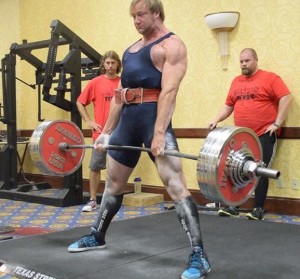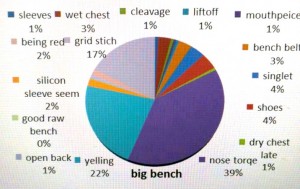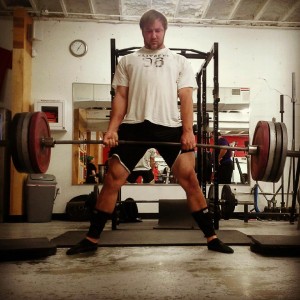Blog
The Method Behind the Madness
Since I started coaching powerlifting classes at ASF, my athletes will sometimes ask me why I chose a particular barbell exercise as the main movement for a given day. Recently I was talking to Mark Rogers about this and we agreed it might be interesting for people to understand what goes into choosing exercises for our lifters. When I’m writing a program for mine, here are the things I consider:
 Training Experience
Training Experience
The three events in powerlifting are the squat, bench press and deadlift. An athlete might need weeks or months to acquire basic proficiency in these lifts, and decades to perfect and hone their technique. When an athlete comes to me with no experience in powerlifting or with improper technique, my first priority is teaching them how to execute the three lifts for maximum strength and safety.
One of the great things about training at a gym like ASF is that we have a full complement of specialty bars, bands and chains that allow a lot of variety in what we can do, and the clients we can accommodate. These bars are fantastic for circumventing old injuries or increasing someone’s comfort level. However, to expedite learning and prevent confusion as the athlete learns new movements I don’t vary exercises much for novice lifters. They primarily perform the competition movements on the competition bars for the first several months, until the fundamentals of the squat, bench and deadlift are second nature to them. My intermediate and advanced level lifters will use the full range of specialty bars ASF offers because they’ve learned how to perform the competition lifts and can benefit more from special exercises that force them to concentrate on particular aspects of their technique.
Specificity
 Specificity refers to how closely an exercise is related to what an athlete does in competition. Especially for our intermediate and advanced lifters, we use a variety of exercises which have different levels of specificity for powerlifting. Exercises which are very specific should carry over better into better results at meets but absolute specificity is not necessary for an exercise to be useful in your training. The major factor I use to determine the level of specificity in my athletes’ training is how many weeks out they are from their next competition. If an athlete isn’t competing for another 2-4 months I am not as concerned with small differences in their technique between their training lifts and their competition lifts. Conversely, when an athlete is competing in 1-4 weeks, their mastery of the actual competition lift is my main priority.
Specificity refers to how closely an exercise is related to what an athlete does in competition. Especially for our intermediate and advanced lifters, we use a variety of exercises which have different levels of specificity for powerlifting. Exercises which are very specific should carry over better into better results at meets but absolute specificity is not necessary for an exercise to be useful in your training. The major factor I use to determine the level of specificity in my athletes’ training is how many weeks out they are from their next competition. If an athlete isn’t competing for another 2-4 months I am not as concerned with small differences in their technique between their training lifts and their competition lifts. Conversely, when an athlete is competing in 1-4 weeks, their mastery of the actual competition lift is my main priority.
Specificity has been a hot topic lately and many coaches advocate training on competition bars year round. I disagree with this for three reasons. First, in competition you are performing only one repetition. Therefore, the number of reps you’re doing in the gym and how close the weights are to your personal best also determine specificity. Lifting light weights for many repetitions is also not perfectly specific to competition, even on the competition bar. Second, competition squat and bench bars are more prone to cause discomfort the shoulders if used exclusively for months on end. By leveraging all the equipment ASF offers me I can keep my athletes healthy in the first portion of their training cycle and have them doing high-quality, highly specific movements pain free when they are near competitions and need that practice. I like to use the competition bars for the heavier, lower volume work and specialty bars for lighter, higher volume work. Lastly, in general specialty bars only change the position of the shoulders. Regardless of the bar I’m using, my ankles, knees, hips and spine are moving the same way they will be on the day of the competition.
When We Used It Last
Many of my lifters will begin their training by working up to the heaviest weight they can lift one, two or three times on a given exercise. I change this exercise every week and I generally do not use the same exercise more than every 3 months. This ensures that the next time they do it their strength has improved enough to beat their old number, which is positive feedback for them and lets us know that their strength is improving.
Does It Address Their Weakness?
Every athlete is different and part of my job is assessing their strengths and weaknesses. The best reasons to have a coach are that they can see what you cannot, give you cues to fix improper technique and draw on their experience to prescribe exercises that will bring up your weaknesses. So last but not least, one of the most important things I consider when choosing exercises is whether or not they address my athletes’ needs. Weak points are low-hanging fruit; fixing them is the best opportunity I have to get my lifters stronger and keep them healthy. Regardless of their skill level, my lifters will follow their main exercise for the day with several more which are designed to correct their specific muscular weaknesses and technical flaws.
In summary, your coaches consider several factors in order to choose exercises that address your weaknesses, keep you healthy and improve your performance. The variety of equipment we have at ASF lets us work with a wider spectrum of clients and maximize our return on the time we spend training.
 About Jeremy Schraw: Jeremy Schraw is a doctoral candidate in nutrition at the University of Texas and a competitive powerlifter with best lifts of a 771 squat, 507 bench and 667 deadlift. When he’s not in the lab, he devotes his free time to the fine art of picking things up and putting them down with his teammates and clients at Austin Simply Fit.
About Jeremy Schraw: Jeremy Schraw is a doctoral candidate in nutrition at the University of Texas and a competitive powerlifter with best lifts of a 771 squat, 507 bench and 667 deadlift. When he’s not in the lab, he devotes his free time to the fine art of picking things up and putting them down with his teammates and clients at Austin Simply Fit.